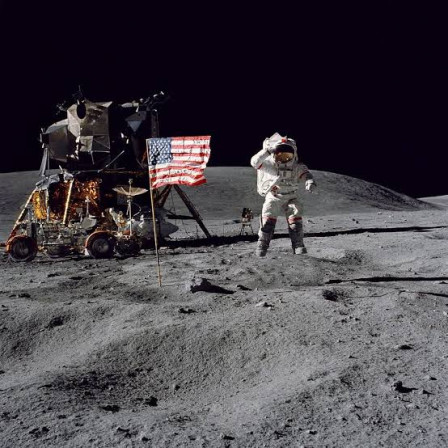Why USA discontinued manned mission to the moon after 1972
Posted on Sunday 04 February 2024, 08:30 - Tech - Permalink
- Article
- |
- Comments (0)
- |
- Attachments (0)
 Q. Between 1968 and 1972, NASA launched nine human missions to the moon. They stopped after 1972 and no country ever sent a manned mission to the moon. Isn't it odd? Did USA really go to the moon?
Q. Between 1968 and 1972, NASA launched nine human missions to the moon. They stopped after 1972 and no country ever sent a manned mission to the moon. Isn't it odd? Did USA really go to the moon?
HS: Yes, they did. However, all the visuals that you see were not taken on moon. Some are.
Q. The reason?
HS: The presence of ET crafts in the videos.
Q. So what happened after 1972?
HS: The inability to cross the Van Allen radiation belt while keeping the astronauts alive.
Q. But NASA says that the radiation exposure is minimum on the astronauts because of the short duration it takes to cross the belt?
HS: Its a lie, like many others they tell you.
Q. So how did they carry out the missions from 1968 to 1962?
HS: They retrieved light radiation shields from a crashed UFO of unknown composition which could not be reverse engineered. Humans had anti-radiation shields made from Lead. But that required to be thick to work and lead is heavy. Such a radiation shield required enormously powerful rocket which was and still is not available. All the retrieved radiation shields were consumed by 1972. Hence no more manned moon missions. Soviet Union was also aware about this from unmanned missions and hence did not attempt any manned mission
Q: What's such a shield made of that no radiation escapes?
HS: Alloys unknown on your planet. As you know, metallurgy on Earth largely involves mixture of component metals and substances. These devices are made of alloys which are chemical compounds of other base metals, much the way it is common for sodium and chloride to combine and produce a substance with properties completely different from the base elements.
The principle obstacle is the human inability to identify the materials, the metallic parts, of this device. Human technology does not yet allow chemical manufacture of metals to this extent.
These metals completely absorb radiation. The foils found, then used to protect lunar capsules passing through the Van Allen radiation belts were made in a similar fashion.
Q: I read an article about NASA pushing the recently planned manned moon landing back until 2026. I was under the impression that we (humans) no longer had the capability/technology to safely cross the Van Allen belt. From what I remember, we accidentally stumbled upon that 'technology' from a crashed alien craft but no longer have that capability/technology today. I would appreciate your input on this topic.
HS: Humans have had the technology to protect against radiation since very shortly after discovering what radiation is, i.e. radioactive particles.
The challenge is weight; a manned spacecraft with sufficiently thick lead shielding (or other very heavy metal) would not be able to achieve orbit, given rocket booster technology of the late 1960s and early 1970s.
Human rockets have not gotten much more powerful since then, but mostly more efficient.
(Note: Automobiles are similar; a current large Chevrolet vehicle significantly outweighs a Cadillac from the 1960s, but with "only" a 5.3 liter engine. The "Caddy" six decades ago had a 7 liter then a 7.7 liter guzzler under the hood but made less power than the modern General Motors 5.3 engine. In a drag race, the Chevrolet of today at 2600 kg would show its taillights pretty quickly to the 7.7 liter, 2,000 kg Cadillac .)
The postponement of the mission is for both political and scientific reasons; the ongoing process to develop light enough radiation shielding material is half of the reason given to project staff & leaders, and is correct. The other half is political, the risk of bad publicity and the effect that might have on the election in November of this year.
Q: So if lead is too heavy, what did they use to protect the astronauts for the manned moon missions in the 60's?
HS: Investigators discovered inside crashed alien ET vessels or ships, many items, materials and devices, among them a foil made from an unknown alloy of elements, which do not exist on Earth.
The foil blocks high intensity radiation better than 30cm/12 in thick lead, with the weight of aluminum foil and twice the thickness (30 microns) of typical aluminum foil (15 microns) sold at a supermarket.
The problem became removing and installing it again and again; you can't repair it by, for example, by melting it down and recycling it. You don't have this alloy on Earth, thus do not know its properties and would risk losing all of it.
Using it to shield a returning capsule that passes through the Van Allen Belts to re-enter the atmosphere, where the exterior surfaces get really, really hot, especially across the ceramic heat shield (even a small gap in foil coverage could allow enough radiation to enter and seriously injure or kill the astronauts) then splashing down on the ocean's surface? Plus removal and re-attachment to a new space capsule? All that work took its toll on the stuff.
You don't have any more of it; no other nation does. No more manned missions above the Van Allen Belts have occurred in a half century.



